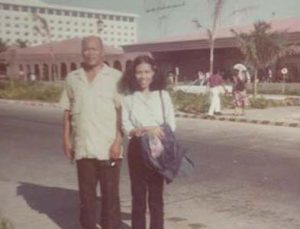Filipino and Filipino American Nurses in the United States
While I first wrote this article last October for 2020 Filipino American History Month, it’s even more relevant today. As the COVID-19 pandemic rages on, highlighting health equity disparities in our country, we recognize the heavy toll it has taken on Filipino nurses who have been on the front lines.
According to Filipino American National Historical Society, the celebration of Filipino American History Month in October commemorates the first recorded presence of Filipinos in the continental United States. On October 18, 1587 “Luzones Indios” came ashore from the Spanish galleon Nuestra Senora de Esperanza and landed at what is now Morro Bay, California. In 2009, U.S. Congress recognized October as Filipino American History Month.
My mother came to this country in 1980, from the Philippines to work as a nurse after her father told her, “Go to the U.S. Become a nurse and you’ll make a lot of money.” While a career in nursing can be lucrative, no one told my mom how hard it would be to adjust to life in the U.S. In suburban Chicago, my mother had to learn to cope with weather and a world where she had no family support system to lean on. Being in a new country was daunting. Thankfully, she met fellow Filipina nurses who became her friends and they formed their own community. In 1982, she made her way to California where she worked as a registered nurse for almost 40 years. Due to COVID-19, she reluctantly retired, having wanted to continue working to keep her busy.
The U.S. has a long history of importing Filipino nurses starting with colonization in 1898. Americans built nursing schools in the Philippines to teach western medicine in English. Post–World War II, U.S. hospitals faced nursing shortages and looked to the Philippines to fill the void with the exchange visitor program. This combined with the 1965 Immigration and Nationality Act made it easier for hospitals to recruit Filipino nurses, many of whom send money back to their families in the Philippines, which helps the country’s economy. However, it hasn’t been easy. Filipinos and Filipino Americans have fought wage and race discrimination, exploitation, and poor working conditions.
The coronavirus pandemic has only deepened these inequities. As of May 2021, COVID-19 has taken almost 600,000 lives in this country, many of them frontline workers including nurses. According to a September 2020 report from National Nurses United, nurses of Filipino descent account for 31.5% of the workforce’s COVID-19 deaths in the United States. That same report also says in California, where about 20% of nurses identify as Filipino, they account for 11 of the 16 COVID-19 deaths in the profession, or nearly 70%. Many Filipino nurses work bedside and critical care making them more vulnerable to COVID-19. I am thankful my mother retired when she did, since she is so vulnerable to the disease.
Immigrant nurses play an integral part in our country’s healthcare systems, I am grateful for my Filipino relatives and Filipino American friends who are fighting COVID-19 on the frontlines. For their sake, I appeal to everyone to do their part to reduce the spread of the virus: wear a mask, wash your hands, and practice social distancing. Being Filipino American and the proud daughter of a Filipina nurse, it’s an honor to celebrate this month, to reflect on our history, and to recognize the hard work and contributions that Filipinos and Filipino Americans have made in this country.
Kristine Wright is the Public Information Specialist at the UW School of Nursing and manages the school’s digital and social media presence.
Read more stories and resources surrounding Asian American Pacific Islander Heritage month here.
